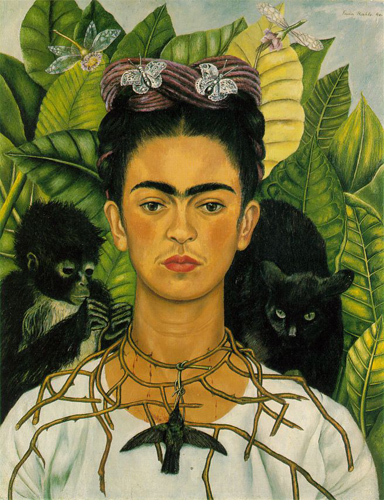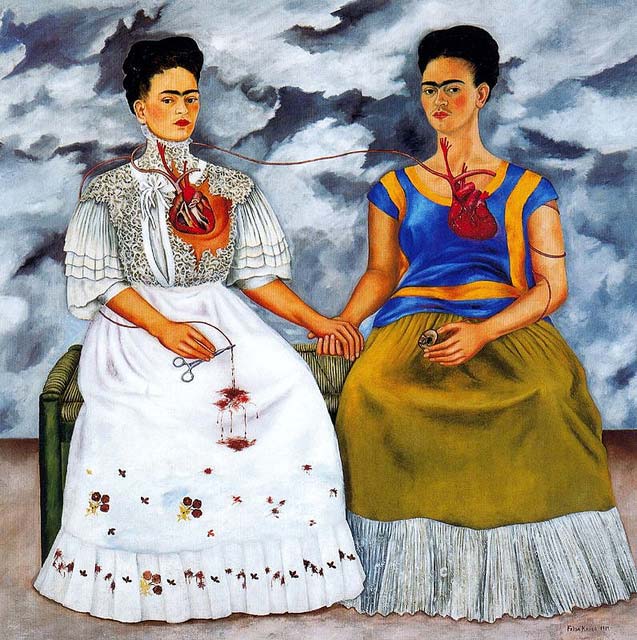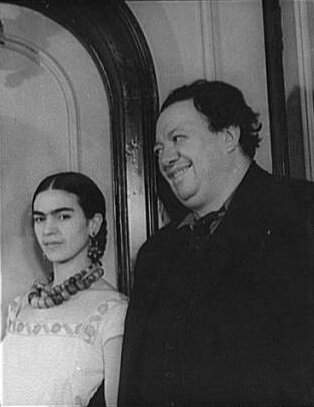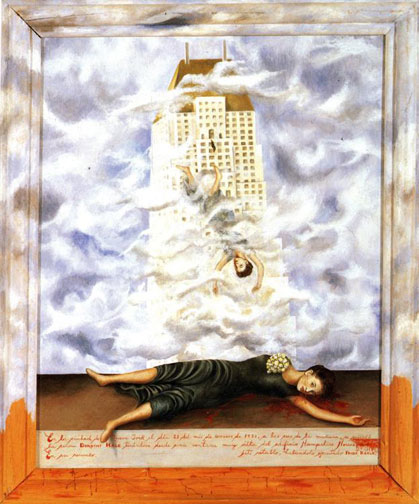| Frida Kahlo | |
|---|---|
 |
|
| Photo by: Wikipedia Creative Commons | |
| Born | Magdalena Carmen Frieda Kahlo y Calderón July 6, 1907 Coyoacán, Mexico |
| Died | July 13, 1954 (at age 47) Coyoacán, Mexico |
| Nationality | Mexican |
| Education | Self-taught |
| Movement | Surrealism |
| Field | Painting |
| Famous Paintings by Frida Kahlo | |
| The Suicide of Dorothy Hale, 1938 | |
| Roots, 1943 | |
| The Two Fridas, 1939 | |
| The Bus, 1929 | |
| Moses, 1945 | |
| The Wounded Deer, 1946 | |
| The Broken Column, 1944 | |
| Without Hope, 1945 | |
| Complete Works |
Born on July 6, 1907, her real name is Magdalena Carmen Frieda Kahlo y Calderón. Her dad was a German immigrant, and her mom was Spanish and American Indian. She was the third out of four siblings, all girls. She also had two half-sisters from her father’s previous marriage.
The Mexican Revolution started in 1910, when she was three years old. She remembered when the gun shots would begin, her mother would usher her into the house and pray. Sometimes, revolutionaries would hop the fence to their yard, and her mom would feed them. Later in life, she would tell people that she was born in 1910, to say she was a product of the revolution, because she sympathized with them.
At the age of six, she contracted polio, which left her right leg considerably thinner than the left. To hide it, she would always wear long, colorful skirts so the defect would not show. She loved to play sports, especially boxing with the neighborhood kids. She was what we say now-a-days a “tom boy.”
In 1922, Frida enrolled in a Preparatoria, which was a girl’s school that is similar to a college at her mother’s request. There were only 35 girls that went to the school, and it was one of the best in all of Mexico. She was going to be a nurse, or something in the medical field. Unfortunately, on September 17, 1925, a bus that she was riding on crashed into a trolley. She almost died, but her injuries turned out to be treatable, however severe they were. Her spinal column, collar bone, ribs, pelvis, and right leg were broken, and her right foot and shoulder were dislocated. The worst part though, an iron handle bar had pierced her abdomen, destroying her reproductive parts and causing internal bleeding.
She spent a majority of the next year in a full body cast, and took up painting to pass time. All her life, this accident haunted her. Sometimes, she would have periods of extreme pain, and would be bed ridden for a few weeks up to a month. She had over 35 surgeries to fix her broken bones. Her spinal column would never be fully heal though, and she wore a back brace to support it for the rest of her life, (although, she never wore it in public). She had to learn to walk again, and her family considered it a miracle that she did.
After she left the hospital, she didn’t go back to finish her schooling. Instead, she kept painting. She felt as if it helped her express her feelings, even when she couldn’t. Her main subject was herself, for, according to her, “I paint myself because I am often alone, and I am the subject I know best.” One of her most famous is The Broken Column, painted in 1940. She has her back brace on, and her top half is nude. Her body is pierced by many nails, and she is crying. This painting reflects her frustration about the accident. The column that is her spine is broken, like her back, and the nails represent the amount of pain she was and is in. Like all her pictures, it is very personal, and expresses all her emotions in one image.
During the few years after the accident, she met Diego Rivera, the Mexican muralist artist. He recognized her talent, and encouraged her to paint more. They fell in love, and in 1929, they were married, but her mother highly disapproved. The relationship was rocky from the start. Diego was jealous that Frida might become more famous than him, and he was angry that she could not bear any children. Frida was frustrated at herself for her inability to have kids, beacause she really wished that she could. In turn, Diego started cheating on Frida, and she started cheating too. Frida was bisexual, and Diego didn’t mind when she had a female partner, but he became insanely jealous when she had another male one. She even cheated with the women that Diego would cheat on her with. It was when Frida found out that Diego had had an affair with her sister that they finally divorced.
In 1939, at the request of Andre Breton, a Surrealist artist, that she went to Paris. She brought some of her work with her, and it was displayed with the other Surrealist work. One of her paintings, The Frame, was bought by the Louvre, and at it was the work by a Mexican artist to be purchased by a big, renowned museum.
Diego and Frida remarried in 1940, for they had been getting along since they had divorced. Again, this relationship was just like the first one, and they just separated for good. Both of them were communists, and they invited Leon Trotsky and his wife over when they were visiting Mexico. The Russians stayed in their houses with them, and eventually moved to Mexico when they became politically disfavored by Stalin.
A few days before she died, Frida wrote in her diary, “I hope the exit is joyful-and I hope I never return.” Frida hated her life when she was older, because her injuries hurt her more than ever, and the leg that had been broken had to be amputated for it had contracted gangrene. On July 13, 1954, she passed away. Diego, late made a statement, saying that the day Frida died was the worst day of his life, because he realized that when he was with her he was the happiest, and that he regretted not appreciating her more while he had the chance.
Frida only became famous in the 1980’s when the feminists were reviving all artwork by women. Her contribution to art was finally recognized, and now is one of the most prominent artists of all time. The symbolism in her art keeps her from being classified as a Surrealist, and her significant influence in Mexican culture makes it unique.


